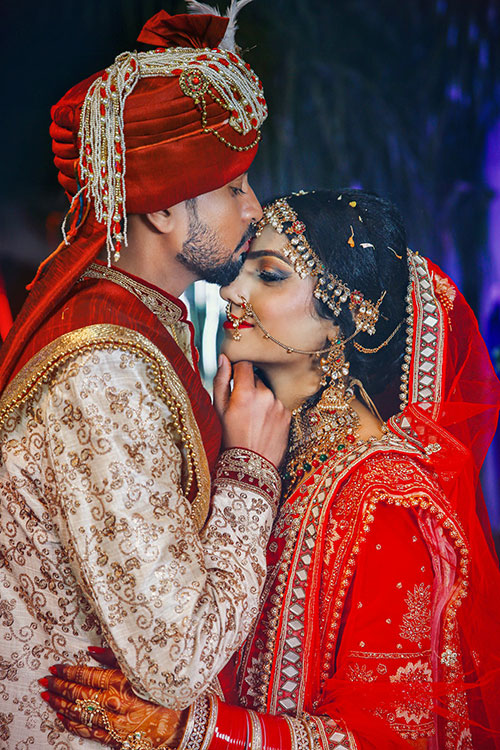 Indian traditional wedding is always a cheerful and colorful occasion. It’s full of tradition. Such a festivity is definitely worth observing or – if you’re lucky – participating in. Vivid colors, rich décor, flowers and greens everywhere, plenty of singing and dancing, tasty food, millennia-old rituals, and so much more. But to really understand what’s going on, a person (especially a foreigner) should learn the meaning and symbolism of various Indian marriage rituals and traditions. That’s what we’re going to do right now, together.
Indian traditional wedding is always a cheerful and colorful occasion. It’s full of tradition. Such a festivity is definitely worth observing or – if you’re lucky – participating in. Vivid colors, rich décor, flowers and greens everywhere, plenty of singing and dancing, tasty food, millennia-old rituals, and so much more. But to really understand what’s going on, a person (especially a foreigner) should learn the meaning and symbolism of various Indian marriage rituals and traditions. That’s what we’re going to do right now, together.
First of all, you should know that an Indian traditional wedding usually lasts a few days – from 2 to 7 days. It’s a great festivity and important event for every Indian couple. And it’s intertwined with rich Indian culture – lots of curious customs and rituals are performed, some of which are 2,000 years old. So, let’s look at some of these rituals closer and explain what they represent.

Henna or Mehndi party
Indian women have a henna party before the wedding. The bride and her bridal party have their hands and feet painted with mehndi patterns. Skillfully made, these temporary tattoos look striking. And, by the way, they make magnificent wedding photo ideas. So, if you’re invited to an Indian wedding, never refuse to take part in a henna party.
Sangeet – welcome reception
As Indians love music, dancing, singing, and spectacular performances, they can’t miss an opportunity to turn a welcome reception into a merry party with invited dancers and singers. It looks like a small concert for the family of the couple. In some cases, guests just observe, but often, they participate, singing and dancing along with the performers or taking part in certain wedding rituals.
Prayers before wedding
Many Indian traditional wedding ceremonies begin with a morning prayer. Usually, not all of the guests participate in this ritual, only the immediate family of the bride and groom. But this event is also interesting and bright. It differs hugely from Christian or Muslim prayers.
Baraat – meeting of groom’s and bride’s families
This part of the wedding is extremely colorful, cheerful, loud, and warm. The relatives from the groom’s side make a large procession and meet the bride’s procession. As weddings are often huge, with hundreds of people attending, there is a whole see of people in both processions. The groom traditionally rides a horse or even an elephant or – if animals aren’t allowed to the wedding venue – a fancy car. Loud music and singing sound and everybody have fun. The baraat procession usually lasts for about 45 minutes.
Wedding ceremony rituals
When both sides’ processions meet at the venue, the actual marriage ceremony begins. The groom walks in first, of course. Like at practically any wedding ceremony around the world. At once, his shoes are stolen – this is another traditional ritual. He would have to pay money to get his footwear back.

About 10-15 minutes after the ceremony has started, the bride walks in. At European-style weddings, she is accompanied by her father, but Indian brides walk down the aisle not just with one important man in her life but also with uncles, cousins, and other male relatives. In some cases, the bride is even carried on a special ornate handbarrow.
When both the bride and the groom are ready, the official part starts. The aisle is organized in the shape of a tent or arch – large canvas pieces are beautifully draped from a wooden frame and embellished with fresh flowers. This construction is called a “mundap”. And people should be barefoot under the mundap.
The official ceremony lasts for about 1-2.5 hours.
No kissing
Indian couples don’t kiss at the end of the marriage ceremony. They don’t have this ritual, so popular in America and Europe.
Instead, a family photoshoot starts at once, right at the aisle. Indian families are usually very close-knit, so the wedding photo time lasts rather long.
Wedding reception
Wedding dinners are usually plentiful and delicious. Indian food culture is very rich, so there are so many dishes that are traditionally served at a wedding.
Though, there may be some rules as to beverages. For example, at some receptions, strong alcohol isn’t served at all. But wine or other lighter drinks are perfectly fine.
In general, Indian wedding reception is similar to any Western-style wedding meal.

